All the solutions provided in McGraw Hill My Math Grade 5 Answer Key PDF Chapter 11 Lesson 9 Metric Rulers will give you a clear idea of the concepts.
McGraw-Hill My Math Grade 5 Answer Key Chapter 11 Lesson 9 Metric Rulers
Use a ruler like the one shown to measure objects to the nearest centimeter or to the nearest millimeter.

Measure It
Find the length of the piece of chalk to the nearest centimeter.
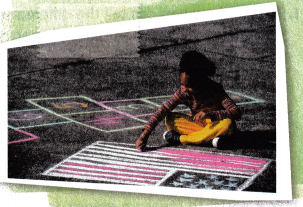
1. Place the ruler against the piece of chalk. Line up the zero on the ruler with the end of the piece of chalk.

2. Find the centimetre mark that is closest to the other end.
To the nearest centimeter, the length of the piece of chalk is __________________ centimeters long.
Answer:
From the above-given measurement:
We placed a ruler against the chalk piece.
The centimetre marks from starting to the endpoint.
To the nearest centimetre, the length of the piece of chalk is 4 centimetres long.
Try It
Find the length of the toy car to the nearest millimeter.
1. Place the ruler against one edge of the car. Line up the zero on the ruler with the end of the car.

2. Find the millimetre mark that is closest to the other end.
To the nearest millimeter, the toy car is _____________ millimeters long.
Answer:
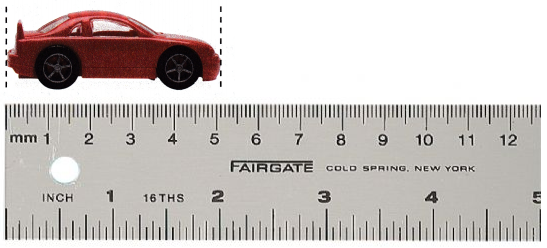
Place the ruler against the car. Now measure the length in millimetres.
The nearest millimetre, toy car is 51 millimetres long.
Talk About It
Question 1.
Explain how you can tell the difference between the centimeter and millimeter marks when measuring an object with a metric ruler.
Answer:
– Centimetres are used for measuring a person’s height. On the other hand, millimetres cannot be used for measuring a person’s height.
– The unit system used in the centimetre is Metric. On the other hand, the unit system used in millimetres is SI derived unit.
– The symbol used for measuring centimetres is cm. The symbol used for measuring millimetres is mm.
– The SI unit for measuring centimetres is 10mm. But there is no SI unit for measuring millimetres since it is derived from the SI unit itself.
– The unit used to describe centimetres is length since it is mainly used for measuring the length of an object. Likewise, the unit used to describe millimetres is length since it is used for measuring an object’s length.
Question 2.
Is it easier to measure objects to the nearest centimetre or to the nearest millimetre? Explain.
Answer:
It is easier to measure to the nearest centimetre because the units are larger.
Question 3.
Mathematical PRACTICE Justify Conclusions Should you measure the length across a penny to the nearest centimetre or millimetre? Explain your reasoning.
Answer: millimetre
Explanation:
Small units of length are called millimetres.
Therefore, the answer is millimetre because it is a smaller unit so you can get a more precise measurement.
Practice It
Measure the length of each object to the nearest centimetre and millimetre.
Question 4.

Answer:
There are two sides of a ruler, centimetre/millimetre and inches. The steps to measure length using a ruler are given below:
Step 1: Choose the unit in which you want to measure length. If you want a value in centimetres, then take the centimetres side of the ruler. If in inches, then take the inches side of the ruler.
Step 2: Place the object beside the ruler starting from point 0 on it.
Step 3: Look at the endpoint and mark the value.
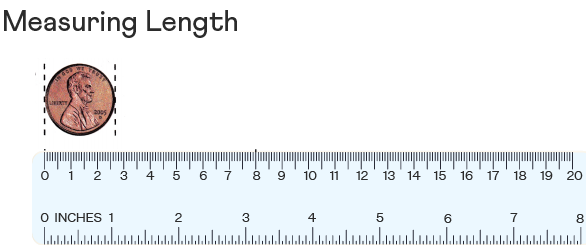
The penny in centimetres: 2.7
The penny in millimetres: 270 mm
1 cm = 10mm
Question 5.

Answer:
There are two sides of a ruler, centimetre/millimetre and inches. The steps to measure length using a ruler are given below:
Step 1: Choose the unit in which you want to measure length. If you want a value in centimetres, then take the centimetres side of the ruler. If in inches, then take the inches side of the ruler.
Step 2: Place the object beside the ruler starting from point 0 on it.
Step 3: Look at the endpoint and mark the value.
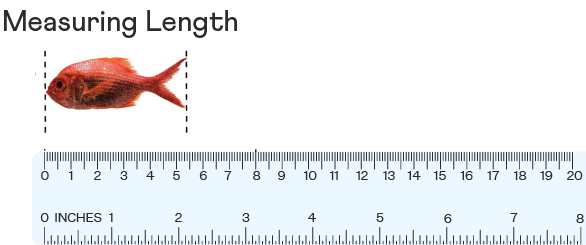
The measurements of fish are near centimetres are 5 centimetres.
The measurements of fish are near millimetres are 54 millimetres.
Find the length of each object to the nearest centimetre and millimetre.
Question 6.
width of a book ___________________
Answer:
The size of a book is generally measured by the height against the width of a leaf, or sometimes the height and width of its cover.
The average book width is 14 cm
In millimetres, we can say 140 millimetres.
Question 7.
length of a pencil ___________________
Answer:
The sample answer is given:
An unsharpened classic wooden pencil measured together with the eraser is 19 centimetres long.
Depending on the brand also the pencil length varies.
The nearest centimetre is 19 cm
The nearest millimetre is 190 mm
Question 8.
a width of a calculator ___________________
Answer:
a sample answer is given:
The width of a calculator is 1 centimetre
In millimetres, the width of the calculator is 100 mm.
Question 9.
length of a tape dispenser ___________________
Answer:
The length of an actual tape dispenser is about 12.7 centimetres. However, the tape in the dispenser can be much longer. The most common measurement for the amount of tape on a roll is about 762 centimetres.
In millimetres, the length of a tape dispenser is 127mm.
In millimetres, the amount of tape on a roll is 7620 mm.
Draw a line segment with each of the following lengths.
Question 10.
6 centimeters ___________________
Answer:
A line segment has two definite endpoints in line. The length of the line segment is fixed, which is the distance between two fixed points. The length here can be measured by metric units such as centimetres (cm), millimetres (mm) or by conventional units like feet or inches.
we do this by using a ruler:
There are certain markings on the ruler beginning from zero as shown in the fig. given below, these markings divide the ruler into equal parts. Each part is equal to a length of 1 cm and these unit centimetres are further subdivided into 10 parts and each sub-part is equivalent to 1 millimetre.

Question 11.
27 millimeters ___________________
Answer:
A line segment has two definite endpoints in line. The length of the line segment is fixed, which is the distance between two fixed points. The length here can be measured by metric units such as centimetres (cm), millimetres (mm) or by conventional units like feet or inches.
we do this by using a ruler:
There are certain markings on the ruler beginning from zero as shown in the fig. given below, these markings divide the ruler into equal parts. Each part is equal to a length of 1 cm and these unit centimetres are further subdivided into 10 parts and each sub-part is equivalent to 1 millimetre.

Question 12.
5 centimeters ___________________
Answer:
A line segment has two definite endpoints in line. The length of the line segment is fixed, which is the distance between two fixed points. The length here can be measured by metric units such as centimetres (cm), millimetres (mm) or by conventional units like feet or inches.
we do this by using a ruler:
There are certain markings on the ruler beginning from zero as shown in the fig. given below, these markings divide the ruler into equal parts. Each part is equal to a length of 1 cm and these unit centimetres are further subdivided into 10 parts and each sub-part is equivalent to 1 millimetre.

Apply It
Question 13.
Compare the units of length you would use to measure the following: the length of a bicycle and the width of a dime. Explain your reasoning.
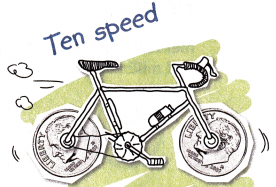
Answer:
The length of a bicycle can be measured in metres(m)
The width of a dime can be measured in millimetres (mm)
1 m = 1000 mm
Question 14.
The length of a cell phone is 8 centimetres to the nearest centimetre and 81 millimetres to the nearest millimetre. Which measurement is more precise?
Answer:
I would say that 8 centimetres would be more precise. Because it is measured with an instrument of least count compare to 81 mm.
Question 15.
Mathematical PRACTICE Find the Error Jessie used a ruler to measure a coloured pencil. Jessie said the pencil is 14.3 millimetres long. Find her mistake and correct it.
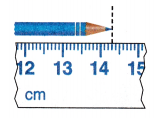
Answer:
She should measure from the initial point of the ruler.
Assume the pencil as a line.
millimetres measurement:

The ruler is in centimetres:
14.3 millimetres = 1.43 centimetres.
She should measure 1.43 cms in the ruler.
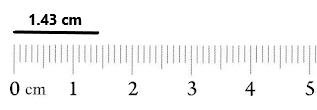
Write About It
Question 16.
Will I get a more precise measurement if I measure an object to the nearest centimetre or to the nearest millimetre? Explain your reasoning.
Answer:
Measuring to the nearest millimetre will be more accurate because it is the smallest unit compared to centimetres.
McGraw Hill My Math Grade 5 Chapter 11 Lesson 9 My Homework Answer Key
Practice
Measure the length of each object to the nearest centimeter and millimeter.
Question 1.
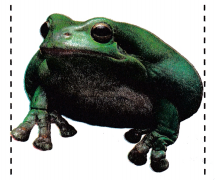
Answer:
Measure the given figure on the ruler.
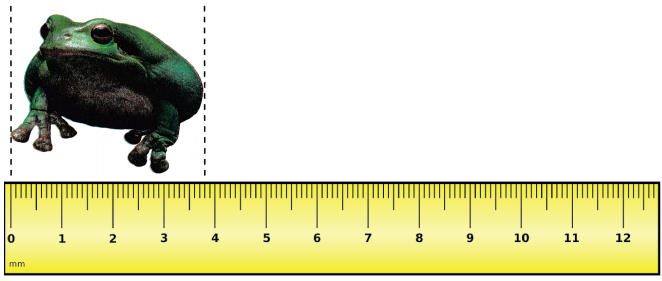
The measurement of the frog in centimetres is 3.5 cm
The measurement of the frog in millimetres is 38 mm.
Question 2.

Answer:
Measure the Pendrive

The pen drive’s nearest centimetre is 1 cm
The pen drive’s nearest millimetre is 13 mm.
Find the length of each object to the nearest centimetre and millimetre.
Question 3.
length of a pen
Answer:

As you can see from the chart that the most popular length of a pen sold by the store is between 130 and 140mm, or 13 – 14 cm and for those of you that prefer imperial measurements it is 5.11 – 5.51 inches. This was closely followed by pens in the 140 – 150mm range.
The nearest centimetres of the pen is 13 cm
The nearest millimetres of the pen is 137 mm.
Question 4.
length of a paper clip
Answer:
a sample answer is given:
The length of the paper clip in the nearest centimetres is 3 cm
In millimetres, we can say 32 mm.
Draw a line segment with each of the following lengths.
Question 5.
7 centimeters
Answer:
A line segment has two definite endpoints in line. The length of the line segment is fixed, which is the distance between two fixed points. The length here can be measured by metric units such as centimetres (cm), millimetres (mm) or by conventional units like feet or inches.
we do this by using a ruler:
There are certain markings on the ruler beginning from zero as shown in the fig. given below, these markings divide the ruler into equal parts. Each part is equal to a length of 1 cm and these unit centimetres are further subdivided into 10 parts and each sub-part is equivalent to 1 millimetre.

Question 6.
105 millimetres
Answer:
A line segment has two definite endpoints in line. The length of the line segment is fixed, which is the distance between two fixed points. The length here can be measured by metric units such as centimetres (cm), millimetres (mm) or by conventional units like feet or inches.
we do this by using a ruler:
There are certain markings on the ruler beginning from zero as shown in the fig. given below, these markings divide the ruler into equal parts. Each part is equal to a length of 1 cm and these unit centimetres are further subdivided into 10 parts and each sub-part is equivalent to 1 millimetre.

Problem Solving
Question 7.
Mathematical PRACTICE Be Precise The length of Manny’s hamster is 114 millimetres to the nearest millimetre and 11 centimetres to the nearest centimetre. Which measurement is more precise?
Answer:
114 millimetres because millimetres are smaller than centimetres, making the more precise.
Question 8.
Lauren has a ruler that is marked in millimetres and a tape measure that is marked in centimetres. Which measuring tool will give Lauren a more precise measurement?
Answer:
We have this relation between centimeters and millimeters. 1 cm = 10mm, So out of the two millimetres is a smaller unit of measurement. Lauren should use a ruler since it shows how long something is or how much space it takes up.
Question 9.
Hanley measured the height of his glass to be 13 centimetres. Sally measured the same glass and found that it measured 132 millimetres. Who used a more precise measurement?
Answer:
The height of his glass Hanley measured = 13 cm
The height of the same glass Sally measured was 132 mm
132 millimetres = 13.2 centimetres
13.2 centimetres is more precise than 13 centimetres. Because you are talking about glass its thickness is measured in millimetres, as opposed to centimetres. Width and height are also typically measured in millimetres as well.